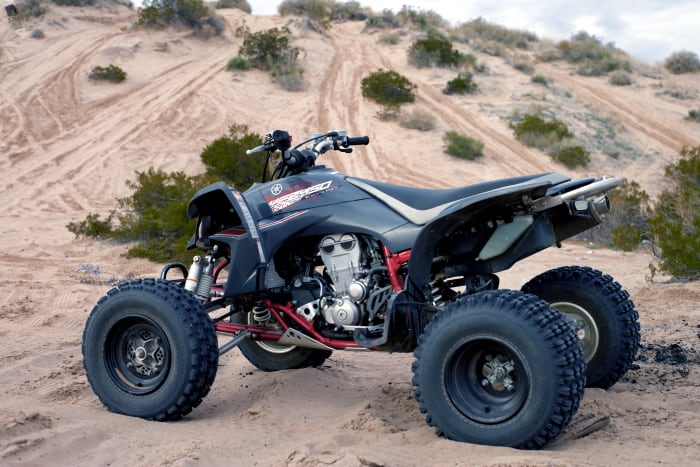If you’ve been around a few different make and model ATVs, then you’ve probably noticed that most of them have different size tires. While that makes the ATV look sporty and aggressive, staggered tires are not just for looks – they improve handling and thus come that way straight from the factory.
But what if your ATV has the same size tires in the front and rear? Could you put different size tires on your ATV or would that damage the transmission?
Why Some ATVs Come With Different Size Tires
Now, before we go any further, let’s talk about why ATVs come with staggered tires from the factory in the first place, and why this setup is superior.
Pros of Staggered Front and Rear Tires
First off, skinnier front tires make it easier to turn. A lot of ATVs still do not come with power steering – it’s just not necessary in most cases. So, to make steering your ATV easier without using power steering, ATV manufacturers put narrow tires on the front.
They are lighter and have a smaller contact patch with the ground, which means less drag while turning the wheels. Another big benefit of running narrow tires in the front is that they also make it easier to drive around rocks and tight trails.

The rear tires are usually the complete opposite – they’re wide and heavy. Since most ATVs are rear-wheel drive, it makes sense to give the rear wheels the most traction possible. Wide tires have a much bigger contact patch with the ground and do not sink down into the mud as quickly as narrow tires.
Cons of Staggered Front and Rear Tires
There really aren’t too many downsides to running different size tires on the front and rear, but the main one would be spare tires. Instead of just having to carry around a single spare tire that’s the same size as all four tires – with staggered tires, you’ll have to carry two spare tires, which is not possible in most cases.
You can get around that by carrying a spare for the narrow front tires.
Can You Put Different Size Tires on Your ATV?
Let’s get straight to the point: you can run different size tires on RWD ATVs, but you cannot run different height tires on 4×4 ATVs – this is the golden rule of 4x4s.
That’s right, you can run whichever width tires you want – it really doesn’t matter. What matters though is the height of the tires. The front and the rear tires NEED to be the same height (circumference).
For example, if you’ve got 25×10-12 (tire height x tire width – wheel diameter) tires at the rear, then you can run 25×8-11 at the front. The first number, 25 in this case, is the height of the tire in inches – this number has to be exactly the same at the rear and the front. You can mix and match the tire width and the wheel diameter to your heart’s content.
But why does the height of the tire need to be the same?
It all comes down to the transfer case. When an ATV is locked in 4×4 mode, both front and the rear driveshaft will receive the same power and turn at the same speed – there is no differential allowing them to turn at different speeds.
Because of that, 4×4 ATVs always come with the same height tires. That way, both driveshafts are rotating at the same speed and the forces acting upon the gears inside the transfer case are more or less equal.
However, if you put smaller tires on the front, while the rear tires are a few inches higher, then the front tires will rotate faster than the rear tires. In that case, the front tires will be pulling away from the rear tires. This puts extra strain on the transfer case – enough to cause major damage and thousands of dollars in repairs.
Conclusion
Sometimes, tire shopping can be a trick and confusing – especially when it comes to 4×4 ATVs. These types of ATVs are very sensitive to different height tires and should only be fitted with the same height (circumference) tires. In case a 4×4 ATV is fitted with different height tires at the front and rear – the transfer case will most certainly be damaged eventually. The greater the difference in tire height – the greater the damage.
However, if your ATV is RWD, then different size tires really do not matter at all. In that case, you can run whichever height and width tires you want, as there’s nothing that can be damaged.
Jake is the site’s primary contributor.
Motorcycles and automotive repair have been a big part of his family for generations, therefore it’s only natural that he decided to become a heavy-duty diesel tech.
Outside of work, you’ll find Jake restoring and riding rare street bikes and ATVs.